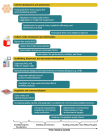Cell-cultivated aquatic food products: emerging production systems for seafood
- PMID: 39113103
- PMCID: PMC11304657
- DOI: 10.1186/s13036-024-00436-1
Cell-cultivated aquatic food products: emerging production systems for seafood
Abstract
The demand for fish protein continues to increase and currently accounts for 17% of total animal protein consumption by humans. About 90% of marine fish stocks are fished at or above maximum sustainable levels, with aquaculture propagating as one of the fastest growing food sectors to address some of this demand. Cell-cultivated seafood production is an alternative approach to produce nutritionally-complete seafood products to meet the growing demand. This cellular aquaculture approach offers a sustainable, climate resilient and ethical biotechnological approach as an alternative to conventional fishing and fish farming. Additional benefits include reduced antibiotic use and the absence of mercury. Cell-cultivated seafood also provides options for the fortification of fish meat with healthier compositions, such as omega-3 fatty acids and other beneficial nutrients through scaffold, media or cell approaches. This review addresses the biomaterials, production processes, tissue engineering approaches, processing, quality, safety, regulatory, and social aspects of cell-cultivated seafood, encompassing where we are today, as well as the road ahead. The goal is to provide a roadmap for the science and technology required to bring cellular aquaculture forward as a mainstream food source.
Keywords: Cell-cultivated seafood; Cellular agriculture; Culture media; Future foods; Scaling up; Tissue engineering.
© 2024. The Author(s).
Conflict of interest statement
The authors declare no competing interests.
Figures






Similar articles
-
Cell-based fish production case study for developing a food safety plan.Heliyon. 2024 Jun 22;10(13):e33509. doi: 10.1016/j.heliyon.2024.e33509. eCollection 2024 Jul 15. Heliyon. 2024. PMID: 39040304 Free PMC article. Review.
-
Differentiation and Maturation of Muscle and Fat Cells in Cultivated Seafood: Lessons from Developmental Biology.Mar Biotechnol (NY). 2023 Feb;25(1):1-29. doi: 10.1007/s10126-022-10174-4. Epub 2022 Nov 14. Mar Biotechnol (NY). 2023. PMID: 36374393 Free PMC article. Review.
-
Cellular Aquaculture: Prospects and Challenges.Micromachines (Basel). 2022 May 26;13(6):828. doi: 10.3390/mi13060828. Micromachines (Basel). 2022. PMID: 35744442 Free PMC article. Review.
-
Tocopherols in Seafood and Aquaculture Products.Crit Rev Food Sci Nutr. 2016;56(1):128-40. doi: 10.1080/10408398.2012.694920. Crit Rev Food Sci Nutr. 2016. PMID: 24915325 Review.
-
Food safety and products from aquaculture.J Appl Microbiol. 1998 Dec;85 Suppl 1:249S-257S. doi: 10.1111/j.1365-2672.1998.tb05305.x. J Appl Microbiol. 1998. PMID: 21182715 Review.
Cited by
-
Global Insights into Cultured Meat: Uncovering Production Processes, Potential Hazards, Regulatory Frameworks, and Key Challenges-A Scoping Review.Foods. 2025 Jan 4;14(1):129. doi: 10.3390/foods14010129. Foods. 2025. PMID: 39796419 Free PMC article.
References
-
- Da Silva JG. Feeding the World Sustainably. The Future We Want? 1 & 2, (2012). https://www.un.org/en/chronicle/article/feeding-world-sustainably.
-
- FAO & WHO. Food safety aspects of cell-based food. Rome 10.4060/cc4855en (2023).
-
- Post MJ, et al. Scientific, sustainability and regulatory challenges of cultured meat. Nat Food. 2020;1:403–15.10.1038/s43016-020-0112-z - DOI
-
- FAO. The state of World fisheries and Aquaculture 2022. Towards Blue Transformation. Rome FAO. 2022. 10.4060/cc0461en.
-
- Fish consumption to double by. 2050, according to new report. New Food Magazine, 15 September https://www.newfoodmagazine.com/news/156644/fish-consumption-2050/ (2021).

